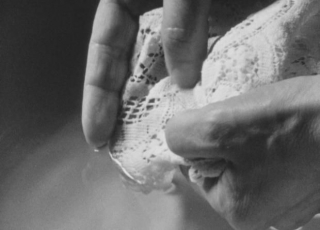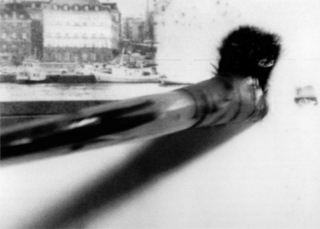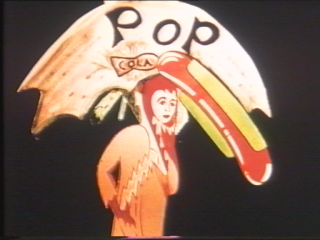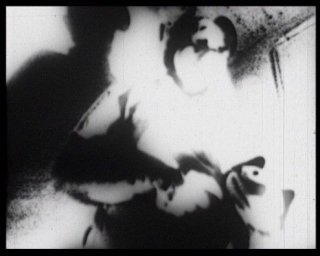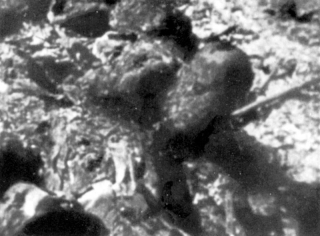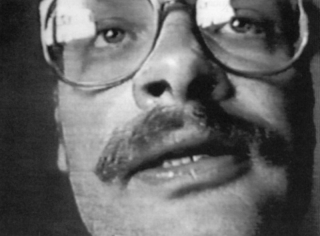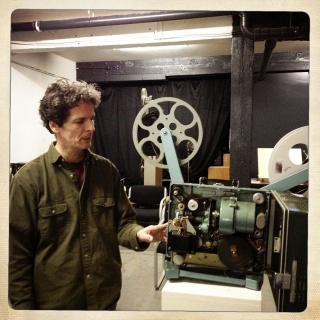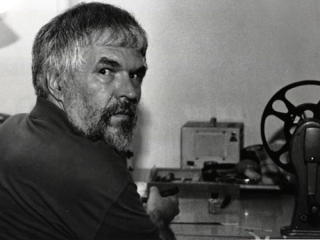Date: 19 November 2002 | Season: LUX Salon
LUX SALON: GUNVOR NELSON
Tuesday 19 November 2002, at 7:30pm
London LUX
Swedish avant-garde filmmaker, Gunvor Nelson was one of the central figures in the avant-garde film movement that emerged in the Bay Area in the 60s. Tonight she presents a selection of her work including the classic Red Shift as well as her recent videotapes.
Gunvor Nelson, Red Shift, USA/Sweden, 1984, 16mm, b/w, sound, 50 min
Gunvor Nelson, Tree-Line (Tradgrans), Sweden, 1998, video, colour, sound, 8 min
Gunvor Nelson, Snowdrift (aka Snowstorm), 2001, video, colour, sound, 9 min
Red Shift is a film in black and white about relationships, generations and time. The subtitle is ‘All Expectation’. The movement of a luminous body toward and away from us can be found in its spectral lines. A shift toward red occurs with anybody that is self-luminous and receding. There is uncertainty about how much observable material exists.
“It involves Gunvor Nelson, her mother and her daughter. Carefully and with great tenderness, it focuses on these three women, trying to show us their relationship, succeeding with an emotional impact that is hardly ever found in such a subject. It is not the social context which is exploited but the little gestures, everyday events. Red Shift is a radical film; it sets new measures for avant-garde filmmaking dealing with personal problems.” (Alf Bold, Arsenal, Berlin)
Date: 20 November 2002 | Season: Oyvind Fahlstrom
GUNVOR NELSON 1: COLLAGE FILMS
Wednesday 20 November 2002, at 6pm
Gateshead BALTIC Centre
Introduced by Gunvor Nelson.
Gunvor Nelson’s collage work extends the artistic possibilities of animation and layered imagery, combining disparate elements into a temporal, cinematic painting. In this sequence of films from the 1980s, journeys through the Swedish landscape are used to depict a sense of displacement from her native country. By showing animation as a process, Nelson creates a unique and freewheeling chain of evocative transformations.
Gunvor Nelson, Light Years, 1987, colour, sound, 28m
Gunvor Nelson, Frame Line, 1983, b/w, sound, 22m
Gunvor Nelson, Light Years Expanding, 1987, colour, sound, 25m
Back to top
Date: 21 November 2002 | Season: Oyvind Fahlstrom
GUNVOR NELSON 2: PERSONAL FILMS
Thursday 21 November 2002, at 7pm
Gateshead BALTIC Centre
Introduced by Gunvor Nelson.
In her personal films, Gunvor Nelson explores relationships within the family. My Name is Oona, a study of her young daughter, was fabricated from just few seconds of looped and superimposed footage (a technique which echoes the mesmeric tape soundtrack by composer Steve Reich). Time Being is a moving, silent portrayal of her ageing mother in hospital, often shot in extreme close-up. Red Shift concerns the relationships between the women of three different generations (Gunvor, her mother and her daughter), made in such a sensitive manner that it appears almost dreamlike.
Gunvor Nelson, My Name is Oona, 1969, b/w, sound, 10m
Gunvor Nelson, Time Being, 1991, b/w, silent, 8m
Gunvor Nelson, Red Shift, 1984, b/w, sound, 48m
Back to top
Date: 23 November 2002 | Season: Oyvind Fahlstrom
ANIMATION & ASSEMBLAGE
Saturday 23 November 2002, at 6pm
Gateshead BALTIC Centre
An outstanding programme of animations by three filmmakers. Åke Karlung was a mixed media artist working on the fringes of the establishment, and made several remarkable works that densely combine collage and live action. The films of painter Erling Johansson are unique fusions of pop art, Swedish folklore and Sami culture. Jan Håfström made two stately and timeless works which seem to exist outside of the modern world, being composed almost exclusively of still photographs, illustrations and engravings.
Åke Karlung, Aliena Kadabra, 1969, colour, sound, 6m
Åke Karlung, Generalrepetition För Självmord, 1963, colour, sound, 3m
Åke Karlung, Homo Ludens, 1964, colour, silent, 4m
Åke Karlung, Det Värdelösa Leendet, 1964, colour, sound, 6m
Erling Johansson, Anima Mundi, 1962-67, b/w, sound, 12m
Erling Johansson, Expulsi, 1969-70, b/w & colour, sound, 17m
Jan Håfström, Orienten, 1969, b/w, sound, 16m
Jan Håfström & Claes Söderquist, Le Genie Civil, 1967, b/w, sound, 11m
Back to top
Date: 24 November 2002 | Season: Oyvind Fahlstrom
SOCIAL & PROTEST FILM
Sunday 24 November 2002, at 3:30pm
Gateshead BALTIC Centre
In the 1960s, Sweden had an active counterculture of artistic events and protest happenings, of which film was an important part. En Svensk Tiger is a critical montage of newspaper headlines and the national flag, while Nixon Visions animates Kjartan Slettemark’s satirical advertising campaign depicting the US President. Öyvind Fahlström’s U-barn is an absurd and surreal montage of found-footage, concerning psychedelic drug use and children’s education. Capitalism is attacked in the punk Coca Strip, while Mass or Monument, made in mid-70s London, is a multi-layered study of the impersonal modern city. Peter Weiss’ Enligt Lag (According to Law) frankly documents life inside a juvenile reform school in the 1950s.
Eric M. Nilsson, En Svensk Tiger, 1970, colour, silent, 3m
Hans Esselius & Kjartan Slettemark, Nixon Visions, 1969, colour, sound, 4m
Öyvind Fahlström, U-barn, 1968, b/w & colour, sound, 25m
Olle Hedman, Coca Strip, 1984-85, b/w, sound, 6m
Åsa Sjöström, Mass or Monument for a Capitalist Society, 1976, b/w, sound, 14m
Peter Weiss, Enligt Lag, 1957, b/w, sound, 20m
Back to top
Date: 4 December 2002 | Season: Infinite Projection
23RD PSALM BRANCH: A MEDITATION ON WAR BY STAN BRAKHAGE
Wednesday 4 December 2002, at 7:30pm
London The Photographers’ Gallery
For the 23rd in his series of 8mm Songs, Stan Brakhage assembled a meditation on the nature of war. The film, which was blown up to 16mm in 1978, is an intricate montage in which the material is manipulated to depict his personal response to the horrific events in Vietnam. “A study of war, created in the imagination in the wake of newsreel death and destruction.”
Stan Brakhage, 23rd Psalm Branch: Part I, USA, 1966/78, colour, silent, 44 min (18fps)
Stan Brakhage, 23rd Psalm Branch: Part II, USA, 1966/78, colour, silent, 41 min (18fps)
“The furthest that Brakhage came in extending the language of 8mm cinema was his editing of the 23rd Psalm Branch … The phenomenal and painstaking craftsmanship of this film reflects the intensity of the obsession with which its theme grasped his mind. In 1966, out of confusion about the Vietnam War and the American reaction to it, Brakhage began to meditate on the nature of war. He amassed a collection of war documentaries and diligently studied newsreels and political speeches on television to the point of speculating on the significance of recurring clusters and shapes of the dots on the television screen. The fruit of his studies and thoughts was the longest and most important of the “Songs”; 23rd Psalm Branch is an apocalypse of the imagination. The conscience of the filmmaker moves between his idea of home and the self and his vision of war. At times the montage of horrors pursues its own split-second dynamic as if forgetting to relocate itself in the passing American landscape.”
(P. Adams Sitney, Visionary Film, 1974. An updated 3rd edition of the book was published by Oxford University Press in 2002)
Back to top
Date: 18 December 2002 | Season: Infinite Projection
GEORGE KUCHAR’S CHRISTMAS CRACKER
Wednesday 18 December 2002, at 7:30pm
London The Photographers’ Gallery
Celebrate the season of good cheer with George, as he serves up a smorgasbord of Yuletide yearning. Since 1986, Kuchar has produced over 300 tapes; each infused with heaps of humour and piles of pathos. This selection of his annual Christmas videos will warm our winter wonderland. Happy holidays!
George Kuchar, Holiday Xmas Video of 1991, USA, 1991, colour, sound, 20 min
George Kuchar, Xmas 1987 (New Year’s), USA, 1987, colour, sound, 13 min
George Kuchar, Dingleberry Jingles, USA, 1994, colour, sound, 21 min
George Kuchar, Fill Thy Crack with Whiteness, USA, 1989, colour, sound, 11 min
George Kuchar, Kingdom by the Sea, USA, 2002, colour, sound, 20 min
“Amid the greenery of what should be a White Christmas there sits the blackness close to my heart, and beyond that there bellows a legion of behemoths who know not shame nor guilt.”
“A veneer of good cheer coats the surface like thin ice, so proceed with caution!” (George Kuchar)
With plentiful seasonal gratitude to Steve Reinke and Abina Manning. Please bring festive treats to share with fellow audience members.
Back to top
Date: 15 January 2003 | Season: LUX Salon
LUX SALON: ALEX MACKENZIE
Wednesday 15 January 2003, at 7:30pm
London LUX
Alex MacKenzie works as a media curator, filmmaker and performer in the film and video fields. His works are simultaneously accessible and abstract, working from a model of both expanded cinema and performance with the serendipity of the hand-processed and degraded image integral to the work. Alex is the primary programmer and coordinator of The Blinding Light!! Cinema, an alternative and underground screening and performance space devoted to presenting cutting edge, underground, and obscure film and video six nights a week in Vancouver, Canada. He is also the Festival Director for the Vancouver Underground Film Festival. This is his first European tour.
“I am currently interested in reconfiguring, repositioning and recontextualizing outmoded and ephemeral film materials and media devices in order to examine them beyond their original intention and as a formal attempt to dehistorify and reinvent meaning.” —Alex MacKenzie
Alex MacKenzie, This Fleeting, 2003, video (originally 16mm), 45 min
Alex MacKenzie, MEDI(CINE), 2003, expanded cinema performance, 16mm, 20 min
PROGRAMME NOTES
LUX SALON: ALEX MACKENZIE
Wednesday 15 January 2003, at 7:30pm
London LUX
THIS FLEETING
Alex MacKenzie, 2003, video (originally 16mm), 45 min
In 1996 I was handed a boxfull of ten-minute reels containing 16mm home movies. Shot on gorgeous Kodachrome and in Black and White the films are an incredible document of a time in history – 1948 to 1957 Vancouver and around the world – a stunning record of people, places and activities. I was inspired to reinvent and retool meaning from these films. Until now this retooling for me has meant a conscious highlighting of intended moments of spectacle, beauty and awe. With This Fleeting, I explore precisely the opposite. What of moments that are unintentional, unplanned, and finally, undesired? This Fleeting is, then, a reconfiguring of the minute and fragile moments of unintended beauty captured by a stranger in the middle of the twentieth century. Exploring the structural and visual fields with equal interest, a language of movement and invisible history is magnified, slowed down and meticulously uncovered. “This Fleeting is a re-take on the empire of family, going back through a single family’s archive and relooking at the moments, the gestures of inclusion and exclusion, the way they’ve managed to say yes with the camera. These home movies were originally made between 1948-1957 and feature bathing beauties, parades, cars, trips abroad and much much more. Relive the dream.” —Mike Hoolboom
MEDI(CINE)
Alex MacKenzie, 2003, expanded cinema performance, 16mm, 20 min
Through a subtle and mesmerising recombination of rare 16mm American medical films (originally intended for doctors’ eyes only), MEDI(CINE) jars us with unexpected clashes of images and subtle gestures of reinterpreted visual and audio information, rendering illness as beauty – the decomposing and recomposing body as site of transformation. Using colour gels, hand-masking and image-layering in a two-screen live presentation, MEDI(CINE) blends original sounds with re-tooled audio in an expanded cinema performance of physical catastrophe. ‘The sheer virtuosity of MacKenzie’s live film performance is enough to blur the line between cinema and historical re-enactment. This is history – that which is made only when reproduced – the vital urge to comprehend what has not been lived, to find meaning in the abandoned fragments of mere grandeur.’ —Jeremy Rigsby, Artistic Director, Mediacity
Back to top
Date: 12 February 2003 | Season: LUX Salon
LUX SALON: AZAZEL JACOBS
Wednesday 12 February 2003, at 7:30pm
London LUX
First-time feature film maker Azazel Jacobs skillfully interweaves four strands of New York life. The city itself is a central character, portrayed in delicate black and white imagery. A young black man who observes and acts as our eyes through his voice-over represents another. The third, forming the central story, involves a young actress, disenchanted by an audition, now struggling to find another way to be herself, in contrast to her flat mate still dreaming of being a star. And fourth are the auditions of a pretentious young director, actually completely unclear about what he seeks, who takes his actresses through the ordeal of convincingly playing their death. While he works with some dangerously familiar motifs of the American indie cinema (agonising young actresses, the making of films about the making of movies), Jacobs gives fresh depth to this territory, always offering a completely convincing and sympathetic portrait of his young New Yorkers and their scene, always keeping us involved. He gets the best out of his actors, the auditions in particular make fascinating performance pieces within the film itself. A film with brains. Premiered at Rotterdam Film Festival 2003, and selected for screening in the Hong Kong Film Festival.
Azazel Jacobs, Nobody Needs to Know, USA, 2003, 95 min
A fresh and absorbing portrait of New York, its streets and views is folded intelligently in with a story of a young New York actress struggling to escape the shallowness of the acting world, heightened by a subtle sub-theme of almost Warholian filmed auditions.
Date: 29 April 2003 | Season: Miscellaneous | Tags: Stan Brakhage
A SNAIL’S TRAIL IN THE MOONLIGHT: STAN BRAKHAGE 1933-2003
Tuesday 29 April 2003, at 7pm
London The Other Cinema
Memorial screening and fundraiser organised by LUX and the Other Cinema, London
An evening of screenings and talk to celebrate the life and work of one of the founding fathers of the modern avant-garde film. Over the course of 50 years and 400 plus films he mapped out a highly personal and passionate alternative history of motion pictures which looms large in the history of American post-war modernism. It is impossible to express all aspects of his work in one screening so instead we aim to present a small sample of works that were important to him, by himself and friends, as well as rare interviews and home movies. A celebration of his life and his remarkable creativity.
Stan Brakhage, Songs 4–7, 1966, 8mm, 10 min
Stan Brakhage, The Dante Quartet, 1987, 8 min
Stan Brakhage & Phil Solomon, Concrescence, 1996, 3 min
Stan Brakhage, Yggdrasill: Whose Roots Are Stars In The Human Mind, 1997, 17 min
Marie Menken, Notebook, 1962-63, 10 min
Bruce Baillie, Rolls, 1967-70, 7 min
Mary Beth Reed, Moonstreams, 2000, 10 min
Courtney Hoskins, Gossamer Conglomerates, 2001, 5 min
Stan Brakhage, Mothlight, 1963, 4 min
Ken & Nisi Jacobs, Keeping an Eye on Stan, 2003, 8 min (excerpt)
Pip Chodorov, A Visit to Stan Brakhage, 2003, 15 min
Colin Still, Brakhage on Brakhage, 1996/2002, 9 min
Phil Solomon, Stan Editing “Panels for the Walls of Heaven”, 2003, 7 min (excerpt)
There will also be selections from audiotapes made by Stan Brakhage for his friends and acquaintances, including the poetry of James Thompson BV and music by Charles Ives and Erik Satie. Speakers will include Pip Chodorov and Al Rees.
PROGRAMME NOTES
A SNAIL’S TRAIL IN THE MOONLIGHT: STAN BRAKHAGE 1933-2003
Tuesday 29 April 2003
London The Other Cinema
PROGRAMME
Selections from audio tapes made for friends by Stan Brakhage, c. 1990s
Introduction by Pip Chodorov
Pip Chodorov, A Visit to Stan Brakhage, 2003, 15 min
Stan Brakhage, Mothlight, 1963, 4 min
suggested by Jonas Mekas
Marie Menken, Notebook, 1962-63, 10 min
Bruce Baillie, Rolls, 1967-70, 7 min
suggested by P. Adams Sitney
Colin Still, Brakhage on Brakhage, 1996/2002, 9 min
Stan Brakhage, Songs 4 – 7, 1966, 8mm, 10 min
Words from A.L. Rees
Stan Brakhage, The Dante Quartet, 1987, 8 min
suggested by Phil Solomon
Phil Solomon, Stan Editing “Panels for the Walls of Heaven”, 2003, 7 min (excerpt)
Stan Brakhage & Phil Solomon, Concrescence, 1996, 3 min
Stan Brakhage reading “The City of Dreadful Night” by James Thomson (BV)
Courtney Hoskins, Gossamer Conglomerates, 2001, 5 min
Mary Beth Reed, Moonstreams, 2000, 10 min
suggested by Ken Jacobs and Pip Chodorov
Ken & Nisi Jacobs, Keeping an Eye on Stan, 2003, 8 min (excerpt)
Stan Brakhage, Yggdrasill: Whose Roots Are Stars In The Human Mind, 1997, 17 min
Charles Ives “General William Booth Enters Into Heaven”
suggested by Peter Kubelka
…
Announcement of Stan Brakhage’s Death, and Statement on his Life
Written by Marilyn Brakhage and released March 10, 2003.
Brakhage, James Stanley (Stan). Died Sunday afternoon, March 9, 2003, about 2:10 PM Pacific Time at Victoria Hospice in Victoria, British Columbia, Canada, after a brave and difficult struggle with cancer. His wife, Marilyn, was with him.
Born in Kansas City, Missouri, in 1933, Stan grew up chiefly in Denver, Colorado and lived for many years in Rollinsville and later in Boulder, Colorado, as well as spending earlier periods in both New York City and San Francisco. Most recently of Victoria, British Columbia, Stan was a world-renowned artist, a creative genius whose complex, brilliant and amazingly prolific body of work in both film and writing earned him a place of prominence within the American avant-garde film movement as well as the entire contemporary art world. With major collections of his work at the Museum of Modern Art, New York, the Oesterreichisches Filmmuseum, Vienna, the Museo Nazionale del Cinema, Turin, and other museums, universities, and private collections around the continent and the world, Stan has been an inspiration to countless students, fellow artists, and so many others, through his films, his writings, his lectures and public appearances, and his work as Instructor at the School of the Art Institute of Chicago, and Professor at the University of Colorado at Boulder.
Most especially, Stan has been an enormous presence in the lives of all who knew him, “a giant among us,” as a friend said. His great love for family and friends, and unending wonder at the world, the strength of his physical presence, the challenge of his mind, the integrity of his being, the light in his eyes, the amazing life-force that he was, will be a huge loss for all of us.
True to form, Stan spent his final weeks and days scratching on film and drawing pictures of his visions, both internal and external, as he worked through his illness. He expressed much love and kindness, and gratitude to others, and said, “I’ve had a really good life,” and “Life is great.” He worried for the world, and he continued to care for and to protect his art, and that of others.
In his well known Metaphors on Vision of 1963, Stan had written of film artists creating “where fear before them has created the greatest necessity,” and that “They are essentially preoccupied by and deal imagistically with — birth, sex, death, and the search for God.” Speaking recently of his life, he stated that most of all he had wanted to GIVE something to people — through the arts, through music and painting. He said, “I wanted to give them God.”
Stan is survived by seven children and 14 grandchildren. He will be deeply missed by his wife, Marilyn, and sons Anton and Vaughn, and by his first wife, Jane, and their five children, Myrrena, Crystal, Neowyn, Bearthm and Rarc.
Funeral services will be held at St. Mary’s Anglican Church on Elgin Road, Victoria, British Columbia, on Friday, March 14, at 3:00 pm.
Back to top
